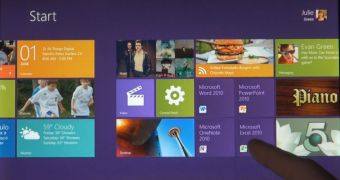Even with the January 2011 demo of Windows 8, Microsoft has made it clear that it intends for the Office productivity suite to work on next generation form factors on top of Windows7’s successor, including System on a Chip devices, such as those powered by ARM architectures. The first official preview of Windows 8 also featured a “guest appearance” by Office 2010, with the software giant demonstrating how the traditional and a new Metro-based UI of Windows vNext could work in tandem.
In the video embedded below just skip ahead about three minutes in and watch from there to see the part I’m talking about.
In the video, Excel 2010, Word 2010 and PowerPoint 2010 are all launched and working on a Tablet PC / slate powered by an early development milestone of Windows 8.
All three Office 2010 components are causing Windows 8 to default to the traditional UI, namely the Taskbar, and do not deliver an immersive experience such as the HTML5 app demoed in the video earlier.
It should be obvious to everybody that Office 2010, much as Windows 7, isn’t tailored to natural user interface (NUI) form factors, but to traditional computers.
Could this change with the advent of Office 15, the next iteration of Office? A recent statement from Kurt DelBene, Senior Vice President, Microsoft Business Division (via SeattlePI) could point to the fact that the answer is indeed “Yes.”
DelBene opined that the Redmond company’s division dealing with Office should be ready for an explosion of productivity on next generation form factors.
At least for the time being, iOS / iPad and Android tablets are ruled out, a situation which I don’t expect to change all that much in the coming couple of years. This leaves Windows 8 as the only Tablet PC operating system to support Office 15 on next gen devices.
“I think it’s open as to whether we get to a point where people do long, rich editing on mobile devices,” he revealed.
Slates are devices focused on content consumption scenarios by default. Lack of traditional input models certainly contributes to this view.
Such form factors are ideal for watching movies & videos, surfing the web, listening to music, viewing pictures, playing casual games, etc.
But in order for them to also support productivity, I fear that software-side innovation into interaction models is simply not enough, although as good a place to start as any.
Personally I think that it’s imperative for the NUI + GUI revolution that Microsoft started with Windows 8 should continue with Office 15.
Leaked copies of Office 15 and the new component dubbed Moorea can certainly be interpreted as hints that Microsoft is moving in the right direction. But a more drastic overhaul of the Ribbon / Fluent UI will be necessary in order for Word, Excel, PowerPoint to be used seamlessly with touch.

 14 DAY TRIAL //
14 DAY TRIAL //